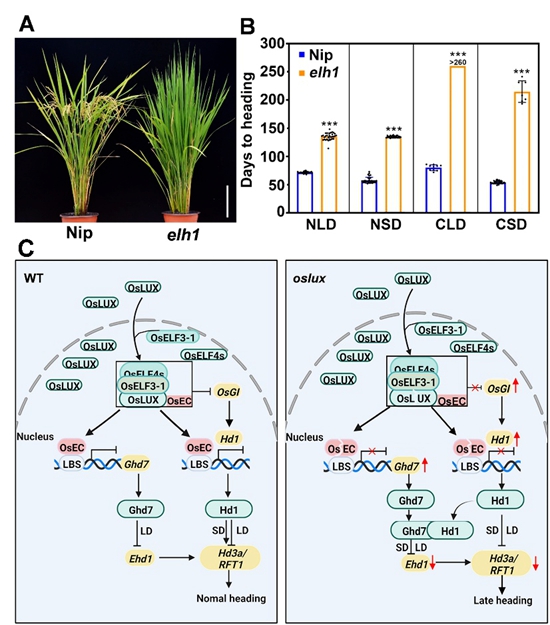Study Reveals How the Clock Component OsLUX Regulates Rice Heading
Critical as is for optimal reproductive growth and yield in cereals, flowering time (heading date) is controlled by a sophisticated genetic network. Among the network components, the circadian oscillator genes play vital roles in coordinating internal physiology and external environmental factors to regulate flowering. Studying how clock genes regulate heading date and uncovering circadian clock regulation networks in rice are topics that have attracted interest from many researchers.
To investigate the regulatory mechanism of the circadian clock in rice heading, researchers from China National Rice Research Institute (CNRRI) of the Chinese Academy of Agricultural Sciences (CAAS) characterized the circadian clock gene OsLUX. The gene encodes an MYB family transcription factor that functions as a vital circadian clock regulator controlling rice heading. Defect in OsLUX causes an extremely late heading phenotype under natural long-day and short-day conditions. The function of OsLUX was further confirmed through genetic complementation, overexpression, and CRISPR/Cas9 knockout. OsLUX forms the OsEC (OsELF4s–OsELF3-1–OsLUX) complex by recruiting OsELF3-1 and OsELF4s, which were required to regulate rice heading. OsELF3-1 contributes to the translocation of OsLUX to the nucleus. Besides, mutation of any component of the OsEC complex resulted in a compromised flowering phenotype.

The study reveals that the OsEC target suppresses the expression of heading date 1 (Hd1) and grain number, plant height, and heading date 7 (Ghd7) directly via binding to their promoter’s LBS (LUX binding site) element. The OsEC–Hd1/Ghd7 regulatory module uncovered by the study provides the genetic targets for crop improvement by selecting various combinations of its components to achieve optimal photoperiod and planting area.
This work was supported by grants from the National Natural Science Foundation of China (32071996, 31871604, and 31961143016), the National Key R&D Program of China (2020YFE0202300), Hainan Yazhou Bay Seed Lab (B21HJ0219), and the Agricultural Science and Technology Innovation Program of CAAS (CAAS-ASTIP2013-CNRRI). The results have been published online in Journal of Advanced Research entitled “The clock component OsLUX regulates rice heading through recruiting OsELF3-1 and OsELF4s to repress Hd1 and Ghd7”.
Link to the paper: https://doi.org/10.1016/j.jare.2022.08.001
By Wu weixun and Shen huizhi (wuweixun@caas.cn, shenhuizhi@caas.cn)
-
 Apr 18, 2024Opening Ceremony of the Training Workshop on Wheat Head Scab Resistance Breeding and Pest Control in Africa Held in CAAS
Apr 18, 2024Opening Ceremony of the Training Workshop on Wheat Head Scab Resistance Breeding and Pest Control in Africa Held in CAAS -
 Apr 03, 2024IPPCAAS Co-organized the Training Workshop on Management and Application of Biopesticides in Nepal
Apr 03, 2024IPPCAAS Co-organized the Training Workshop on Management and Application of Biopesticides in Nepal -
 Mar 28, 2024Delegation from the School of Agriculture and Food Science of University College Dublin, Ireland Visit to IAS, CAAS
Mar 28, 2024Delegation from the School of Agriculture and Food Science of University College Dublin, Ireland Visit to IAS, CAAS -
 Mar 25, 2024Director of World Food Prize Foundation visited GSCAAS
Mar 25, 2024Director of World Food Prize Foundation visited GSCAAS -
 Mar 20, 2024Institute of Crop Sciences (ICS) and Syngenta Group Global Seeds Advance Collaborative Research in the Seed Industry
Mar 20, 2024Institute of Crop Sciences (ICS) and Syngenta Group Global Seeds Advance Collaborative Research in the Seed Industry
